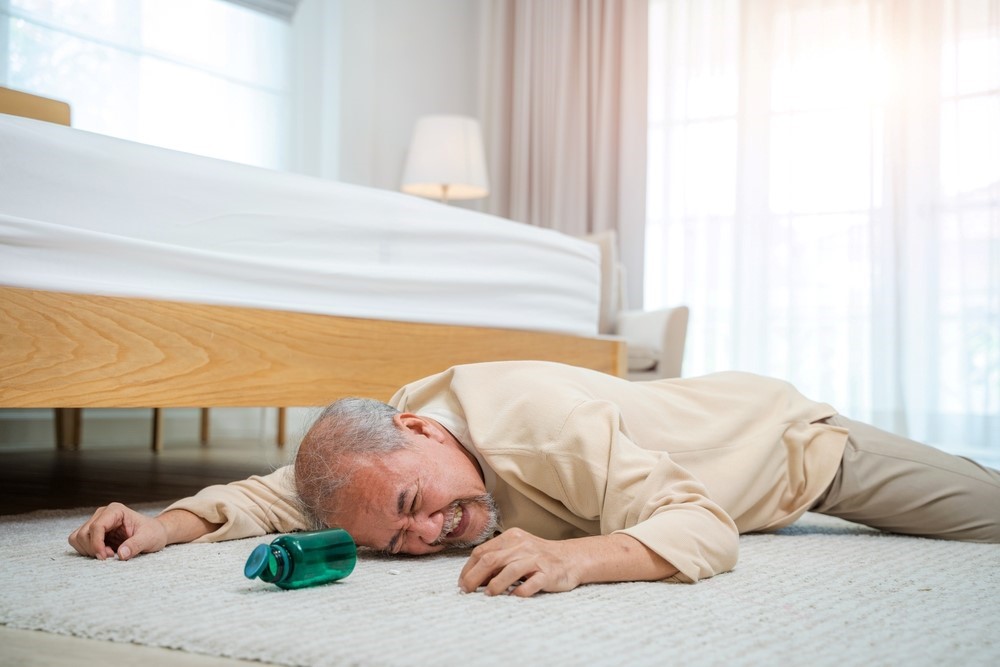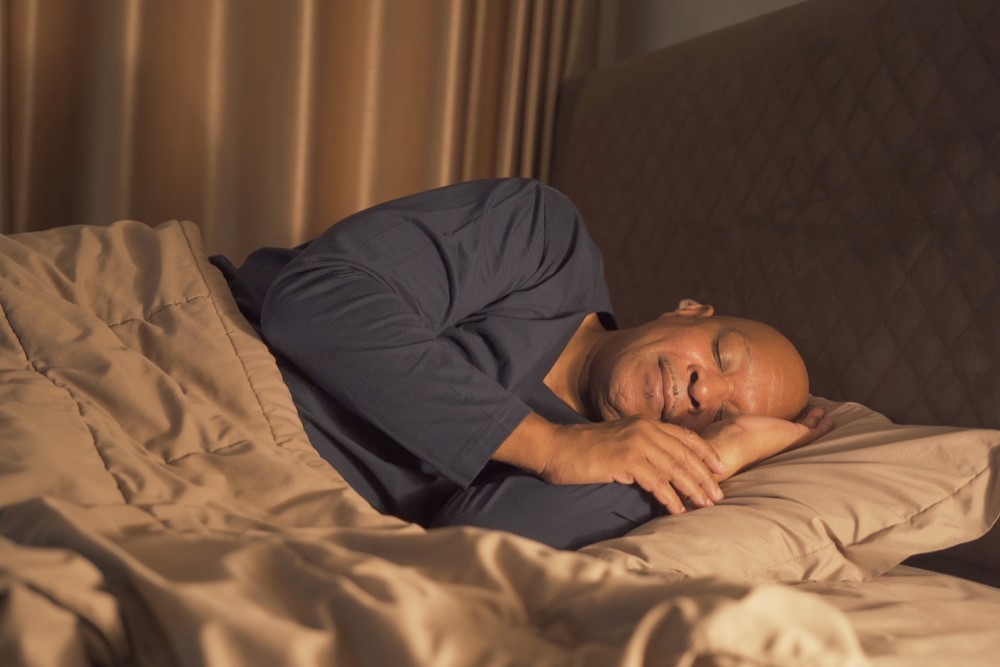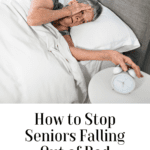
As people age, sleeping in a bed sometimes gets surprisingly difficult. Some seniors regularly roll out of bed during the night, which can be frightening and easily causes injuries. Others may be okay while they sleep, but fall when trying to get out of bed in the morning.
Caregivers often need solutions for how to stop seniors falling out of bed.
Thankfully, there are some useful tools on the market, ones that you can use at home. Most of them aren’t particularly expensive either.
In this post, we’re looking at some of the most powerful products, plus other approaches to help with the problem.
As we go, we’ll talk about the different reasons that seniors fall out of bed and which approaches work best in which situations. After all, the best solution won’t be the same in every situation.
Tools to Stop Seniors Falling Out of Bed
Bed Railings

Bed rails come in many styles.
Some are small and are mainly used to help people get into and out of bed. Others are larger, taking up half the length of the bed or even the full length.
To prevent falls, the bar shouldn’t be too short. At least twice the senior’s body width is a good starting point, although longer bars can be safer.
Of course, such bars can make getting up tricky. To get around this, most bed rails can be easily taken down from the outside. This is particularly true for swing-down bed rails.
The senior might be able to take them down from in the bed too. Whether they can do so depends on the design of the bars and the senior’s abilities. If taking the bars down isn’t possible, some seniors will be able to scoot to the end of the bed and get out that way.
This is something to think about, though. Will the senior be able to get out on their own? If not, will this be a problem?
The Stander EZ Bed Rail is a useful one to begin with. This can fit anywhere from a Twin to a California King mattress and can be set at 26, 34, or 42 inches. It can be easily collapsed down as well, making it a versatile tool.
What They’re Best For: These railings are fantastic for seniors who roll out of bed. They’re also a good starting point, as they’re easy to find and are often portable.
When They Don’t Work: Bed railings are sometimes unsafe for seniors who are confused. Such seniors may struggle to get into and out of the bed as-is. Bars and railings just add to the confusion. Some seniors may even attempt to climb over them, which potentially makes the fall worse.
Also, some seniors may struggle to navigate bed rails on their own. This can mean they feel trapped if they want to get up before there’s someone to assist them. It’s easy to see how this could be mentally and emotionally overwhelming.
Bed Handles
There are also smaller rails with handles. These can often be slotted underneath the bed. They’re designed to be sturdy, as the senior may use them as leverage to get up and down.
These often go by the name bed handle, bed cane, or bed assist rail. They sometimes have pockets as well, which make them even more practical.
When choosing a product, pay attention to the design, the instructions, the reviews, and any weight limits. After all, the senior will place a decent amount of weight on the handle. You need to know that it’s not going to slip.
What They’re Best For: These handles are particularly good for seniors who are shaky or light headed when they get up. The senior can even continue to hold the handle once they are on their feet, until they feel balanced.
The handles can also help seniors with confusion, as they make it easier for them to get themselves into the correct position. Using the handle also makes it easier to stand slowly, further reducing the risk of a fall.
When They Don’t Work Well: The handles function a little like rails too, so they may prevent the senior from rolling out of bed. However, they tend to be quite narrow and often won’t be enough.
If the problem is rolling out of bed, the senior may be better with a bed rail instead.
Homemade Solutions
Bed rails and handles aren’t always the right approach. They can be scary for seniors, particularly those with dementia. They’re also considered restraints in some situations.
To get around this, some people make simple barriers, often using a rolled up towel or a pool noodle under a fitted sheet or mattress protector. The towel or noodle can even be taped in place.
This trick is most often used for toddlers and young children, but can work for seniors too.
The barrier isn’t enough to actually stop the senior from rolling out of bed. Instead, it acts as a gentle physical reminder of where the edge of the bed is.
Because such barriers are easy to make and are fairly inexpensive, it might be best to simply give one a try.
What They’re Best For: Seniors who get easily confused or overwhelmed by bed rails.
When They Don’t Work Well: Some seniors will simply roll over top of barrier. Those with limited strength may find it difficult to get up when they need to.
Using a Pillow or Wedge

You can also buy pillows and wedges that help stop the senior from rolling. Sometimes you just need a large body pillow (or two) that is placed alongside the senior – like this one.
There are also shaped products, including a u-shaped body pillow that’s often used for pregnancy and versions with a section for your feet too.
Such body pillows create a type of nest that can help the senior feel secure and isn’t too restrictive. Sleeping with them may also help relieve some aches and pains, as the pillows can take pressure off joints.
What They’re Best For: Seniors with joint pain and those looking for extra comfort during the night.
When They Don’t Work Well: Seniors who are easily confused may struggle to get up, particularly with a u-shaped pillow that isn’t easy to move aside.
Other Tools And Angles To Consider
Improve How They Get Up
If the senior is mostly struggling to get up, slowing things down can help, a lot.
This may involve teaching and reminding them to slow down and take it gently for a while.
Having a grab bar near the bed is useful too. This helps them to steady themselves and gives them a point of leverage.
Also think about the mattress and the height of the bed. For example, low beds with soft mattresses often place considerable strain on the knees, making them difficult to get up from.
Use Incontinence Products
Incontinence and fear of incontinence can be a factor in seniors falling out of bed.
Sometimes this is because they have an accident while they’re asleep and are then trying to get up with damp and sticky blankets.
Other times, they may urgently need to use the bathroom, so they try to get up quickly. Doing so increases the risk of a fall, especially if they’re also confused or get dizzy from moving too fast.
Incontinence products (including those from Depend and Tena) help to contain accidents, reducing urgency upon getting up and helping to keep the sheets dry.
Bed Alarm
Some families turn to bed alarms. While these don’t prevent a fall, they alert the family if one happens. This can be crucial, as the senior will need support immediately. They certainly shouldn’t end up on the floor for hours.
There are a few styles here.
Some use motion sensing to detect movement in the room. Others are placed on the bed, so they’ll detect when the senior gets up.
For example, the Smart Caregiver Wireless Bed Alarm System uses a mat on the bed coupled with a remote alert monitor. The same company has a Fall Monitor Floor Mat that should alert caregivers when the senior falls, but not when they get out of bed successfully.
Other times the senior may wear a medical alert necklace (like one from Medical Care Alert), so they can easily call for help if they fall.
Sleeping On A Mattress On The Floor
For seniors who can get up and down without too many problems, placing their mattress on the floor could be a short-term solution.
This isn’t something you can stick with, as the floor is too low and potentially too cold to keep the senior healthy. They do need to be in a bed.
Still, you could use a mattress on the floor if they’re regularly falling and you’re hunting for a solution. This approach could work while traveling as well.
Cushioning On The Floor
Some families place some type of padding or cushioning on the floor, like some pillows or even a full mattress. This means that if there’s a fall, the senior has a soft landing.
But, again, this depends on the situation.
Seniors who struggle with confusion or memory could easily trip over anything left on the floor. This could actually end up causing a fall rather than protecting them.
You might be able to find padding that has a low trip risk, like something firmly secured to the floor. But, even then the change in texture could easily be confusing.
Because of these complexities, this approach is best reserved for seniors who are very competent.
Talk To Their Doctor
Tools can make a huge difference, but they’re only part of the story.
It’s also important to think about the root cause. Why is the elderly person rolling out of bed now when they didn’t before? Why are they getting confused or dizzy when they get up?
Talking to their doctor can help you work some of this out.
The answer might be related to a health condition, particularly dementia. However, that’s not always the case.
Some problems could be related to medication instead, like sleeping pills or blood pressure medication. If this is the case, a few medication changes could make a huge difference.
Final Thoughts
Most of the time, stopping seniors falling out of bed will involve trial and error. You’ll need to pay close attention to the possible causes of the falls, then experiment with different solutions to find what works best.
Doing so is a pain, I know.
It would be fantastic if there were a single simple solution. But, people are very different from each other, with distinct needs, personalities, and histories. It’s not surprising that there’s no one size fits all solution.
Feeling Overwhelmed?
Check out our Caregiving Consulting service for personalized support and guidance.


Leave a Reply